Wargame: Airland Battle
2013 RTS/RTT Developed by Eugen Systems, Published by Focus Interactive
Wargame Airland Battle is about the cold war.
It is a game about Soviet tank columns, American air-power and Armageddon unfolding in the Fulda Gap. Even though it is not necessarily an accurate depiction of these things, it is certainly a thematically authentic one. Playing Wargame ALB gives one cause to be thankful that NATO and Warsaw Pact forces never met in earnest.
The reason I would like to talk about Wargame ALB is because it is a perfect example of encapsulating a game’s theme in its mechanics. Wargame’s mechanics foster both an authentic cold war atmosphere of slowly creeping paranoia and, at the same time, convey the shattering violence and speed of a modern war.
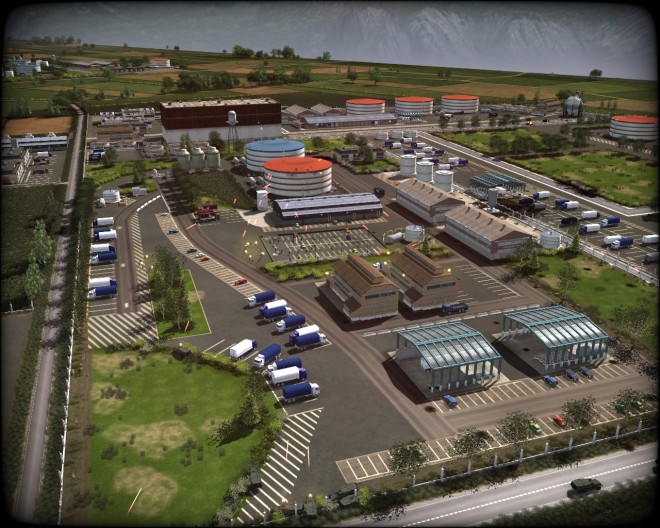
I have, at various points in the course of playing Wargame, been caused to stop and think about how terrifying it would have been to be a soldier trying to obey the orders I have just given. For example, I order two full platoons of infantry to disembark and hunker down into a forest in the line of enemy advance, as I order the main body of their compatriots draw back behind them. These men will have no support, my artillery is busy harassing enemy air defences and they are on the least important sector of my front line. They will not be able to run once engaged, they cannot hope to outpace the clanking monsters soon to pass through the forest, and unless they remain immobile they cannot fire back at them effectively. Their mission, and their only dim chance, is to hold at all costs.
They will not, of course, to stop the armoured, nightmare, horde of T-72s rolling across the German plains towards their temporary redoubt. Rather, I have deployed them to buy my other forces time to regroup. Their heroic deaths (and heroic deaths they were) will buy me about a minute, and might trick the enemy into thinking I have fortified that forest more heavily than I have, causing them to withdraw. For these reasons almost a hundred men will die in the space of a few seconds of violent confrontation. Why them? Because they were the least expensive, and most expendable, aspect of my force—you see, I had one tank that cost more than the whole lot of them, and I needed it to survive. Sorry chaps.
These are the kind of choices one makes in Wargame Airland Battle, they and their consequences are gorgeously presented in bright, attractive, colours. The napalm which bathes the hills is a deep and satisfying orange, while the tell-tale wake of an ATGM darting across the countryside is stark white against vibrant green. Perhaps most seductive of all, the gracefully arcing MRLS trails, sailing through the sky with ease before slapping into poor unfortunates who happen to be at the end of their lazy trajectories.
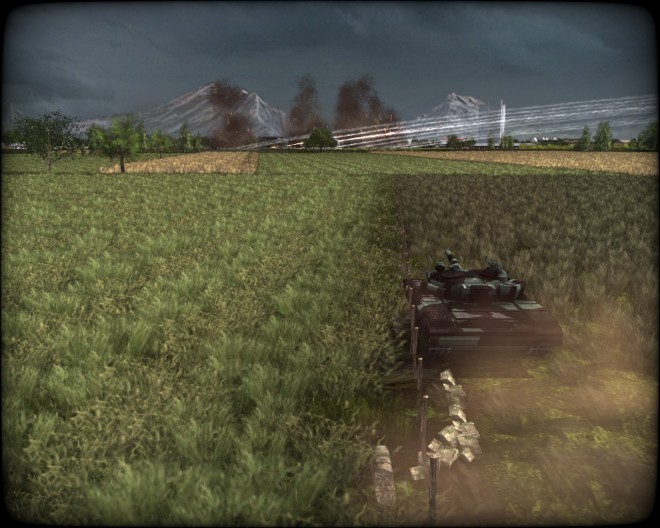
It is the mixture of abstraction and beauty with which the horror of war is portrayed in Wargame ALB that makes it play on my mind. On one hand, I am used to the cold abstractions of a wargame, presented in the clinical style of a mathematical puzzle. When dice are rolled, combat scores tabulated or unit counters collide, we are supposed to imagine that represents the death of virtual soldiers, from a handful to a hundred thousand. In Hearts of Iron 3, for example, a little box pops up after you win or lose a battle (until you turn such notifications off, because you are fighting in Russia and there are a million bloody battles a day), with the men you killed on one side, and the men you lost on another. This never perturbs, or does so only rarely, because these deaths are so abstract that one’s imagination is left without a view from the ground- we can imagine the battles in terms of the movements of squads or battalions, but not from the soldier’s eye view. Those men are literally nobody, more currency than soldiers—as one tries to find a favourable exchange rate between men and territory. In Hearts of Iron nobody with a face ever dies, at least not for reasons other than natural causes.
In Airland Battle on the other hand, your infantry scurry along the ground, almost invisible—aside from their nondescript name-tag or NATO symbol— from on high, but animated (admittedly not well animated) and vital when the camera moves in low. Pure abstraction from the battle is more difficult, all of your units have names, faces and bodies, you can see them struggling. One wants them to live, but the logic of war is sacrifice, and that is what many of these men must become.
Of course, on a real battlefield, one’s men might run away when the odds are too great. The reason that Airland Battle has been so popular with some very competitive players, is partly that it is so very micromanagement intensive. This micromanagement comes in part from the fact units have little to no movement autonomy (while having a fire autonomy that makes the battle manageable), they will not move to engage enemies that they have not been order to attack. Further while units do “panic” and “rout” under heavy fire, Airland battle is not Total War, when units “panic” all that means is that they cannot shoot as fast or as accurately and what a “rout” means is that units dawdle away from enemy fire for a short distance.
The digital men in Airland Battle go where they are sent and they fight to the last man and last round for every inch of ground. One might think that this gives one’s soldiers a robotic air, making the game somewhat less evocative, a dry military simulation devoid of humanity. In my experience however it is quite the opposite. This is not something I think Eugen Systems meant to achieve, but the fact that units will fight to the bitter end, and for the most part hold their position under withering fire, seems to me deeply evocative of the absolute desperation that WW3 would bring with it. Both sides know that they are fighting a total war, and the rhetoric of the time is that this is not only a conflict over territory or power, but a struggle for the future. The enemy is an ideological foe, it is not the 4th Guards Armored Division or the 1st Royal Tank Regiment that stands before you, but forces of red tyranny/imperial fascism. Furthermore, and perhaps more convincingly, in any war running away is the most dangerous thing one can do while the enemy is within striking distance. In historical circumstances, disorganized retreats tend to begin from the not-yet-engaged rear of the retreating force. When soldiers are actually engaged in combat their only way out of that situation tends to be surrender or victory. On the modern battlefield, with the constant threat of precision, long range, munitions there is little space in which soldiers can become easily disengaged from the enemy.
So when a reconnaissance jeep, hopelessly cut off from friendly lines and under fire from all sides, defiantly roars back with bursts of pointless machine gun fire instead of gunning the engine for home, what comes across to me is a panicking and desperate crew doing all they can to save both the world, and their own skins. This differs from the rather Hollywood presentation of fictional cold-war-gone-hot bravery that comes from games like World in Conflict. The men in World of Conflict are stoic soldiers, fighting the good fight with dash and flair. As they speed about the battlefield, unaffected by the whizzbang of fiery death that surrounds them. What comes to mind is chiseled jaws and patriotic sentiments. In Airland Battle, units panic often, but yet they hold their ground. This is a kind of heroism that will be more familiar to readers of history, the startling ability of soldiers involved in modern warfare to be so completely fucking terrified they can hardly shoot straight, but still man the guns and brave the enemy. Such bravery has a pathos to it that the chiseled jaw kind lacks, the Hollywood hero may have to sacrifice themselves, but in the end they will reach victory. Johnny in the foxhole, however, may sacrifice himself but for an outcome that is uncertain, for a reason that he may not know, and with perhaps only a marginal chance that his death will make a difference. This is not unusual to find in games at the scale of, say, the inimitable Close Combat, or Company of Heroes. Both of which do an admirable job in trying to show the soldier as an individual with a modicum of self preservation instinct, cowering behind sandbags and panicking under fire. These games however exist on the platoon scale, near to the ground, far from the abstraction of war-room maps. The unique thing Wargame manages to do, is to infuse the distantly commanded (up to) battalion scale wargame, with the view from the sharp end (indeed, zooming out far enough in a game of ALB nets one a view of the map as if it were placed upon a table, and fades in the chatter of a command center in the background).
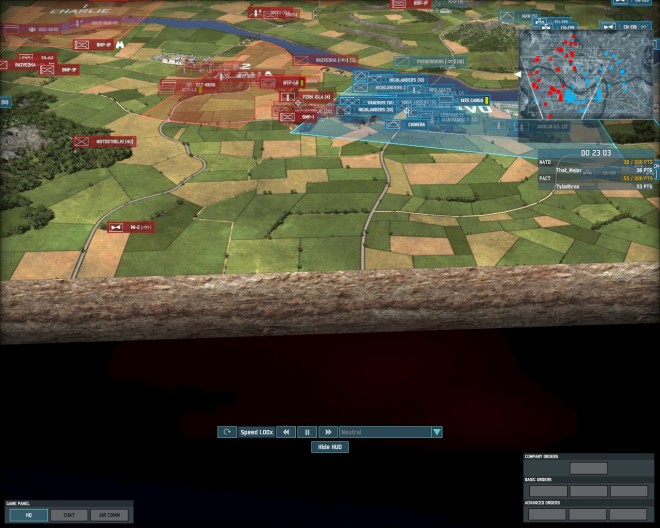
Another pleasing authentic feature of Wargame Airland Battle is the sheer frustration of directing the complicated dance of modern combined-arms operations, supporting one’s various fighting units with logistics, air-cover and reconnaissance elements. When played against human opponents, all the different game play aspects which demand attention now, or threaten to ruin one’s plans, create an almost uniquely stressful experience. As with real warfare, the action consists of a great deal of waiting and planning followed by extreme and rapid responses to fucking everything going wrong all at once. Multiplayer confrontations stand on an absolute knife edge. One must try, with the limited information coming to you from your reconnaissance units, to interpret the intentions of one’s opponent and pre-empt them, while retaining one’s own freedom of action. Simple mistakes and lapses of attention can lead to unwanted escalations in which the linchpins of your planning go up in smoke.
More than anything else, recon units are how Wargame captures the feeling of the cold war period. The game is one of limited and fragile information, a steady stream of which is fed to the player by the limited set of units a player posses that have the equipment to actually make out what is going on, all of which are very easily picked off by the enemy. Further, at the edges of their vision cones, the reports of recon units are indeterminate- they cannot always make out the kind of unit they are seeing. In a game where seconds matter, this can be terrifically important, as it can cause one to do silly things like turn the entire axis of one’s advance to meet, what turns out to be, a couple of unsupported Russian snipers hiding in a bush. In order to get anything done, one must keep the enemy in sight, and one’s own troops out of sight. Therefore one must watch out for the enemy’s recon sneaking around the sides of one’s own vision, while at the same time trying to push that cone as far forward as possible. Losing the advantage here, is so important that it becomes a preoccupation eating away at the back of the mind, further taxing one’s attention span and ratcheting up the danger and tension of the situation.
The result, is an all encompassing paranoia, and a paranoia which is necessary to playing the game well. One’s opponent, in the heat of the game, becomes an object of almost irrational hatred—the bastards are constantly watching you for weakness and they will take advantage of any opening they see. The only option is to annihilate them utterly, preferably from a long way away and with absurd force.
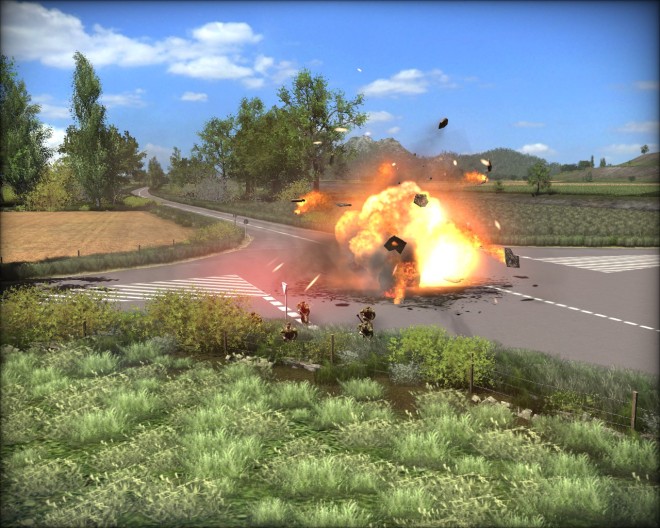
Thus, without any overt prompting, Airland Battle has one experiencing an authentic slice of Cold War paranoia. Nothing in the game ever comes out and says “hey, this game is about a lack of information, and trying to guess the intention of a shadowy opponent in a war the only outcome of which is the annihilation of either your force or his”. However that is precisely what the game is about, and it manages to be about this because of the complex interaction of its systems. Nothing in the game ever really highlights how short and violent its conflicts are, or how horrifying they would be for the human beings that would fight those conflicts—there are no real characters in Airland Battle, certainly no one with a story arc. However, once again, the systems of the game stress both the power and fragility of units. The most powerful tanks can be lost in seconds to an ATGM to the rear, and the most expensive aircraft can be swatted out of the sky in just a couple of shots from hidden anti-aircraft units. This fragility adds a certain atmosphere anxiety to their use which binds a player to them, personalizes those units to a degree, and makes their deaths a horrible psychological blow.
One aspect of the cold war is somewhat obviously lacking from Airland Battle, and that is nuclear weapons. They are, it must be said, present in the game. Albeit in a marginal role as an underwhelming strategic weapon in the curates egg that is Airland Battle’s campaign mode. However, that is not to say that the game lacks weapons of mass destruction, and jaw dropping displays of instantaneous explosive violence. One of the large changes from Airland Battle’s predecessor, Wargame European Escalation, was the introduction of jet aircraft. The role that jets play in the game, is the rapid deployment of firepower to almost any part of the battlefield, and the firepower they bring is truly impressive (the Americans in particular have one or two aircraft with an absolute mess of bombs) and while none of the ordnance is nuclear, the rather generous (some explosions end up being about half a kilometer wide, or more, in the game’s scale) modelling of air launched explosives means that a satisfying level of town leveling destruction can be wrought by air-strikes. Planes can also carry anti-tank missiles, the cheapest of which can cripple the most expensive tank in a lucky run, the most expensive of which can fire a salvo that clears a road of all armor. The sheer power of these weapons can be surprising for a player, and it takes a while to understand that their power must be avoided more than it is countered. So while the prospect of global thermonuclear Armageddon is not centre stage in Airland battle, the immense power of modern weaponry certainly is. It can be distressing to see one’s armored push completely halted by an anti-tank missile spewing warbird, even more so when you know that it was almost entirely your fault that hundreds of men and millions of pounds of equipment have just disappeared in a matter of seconds.
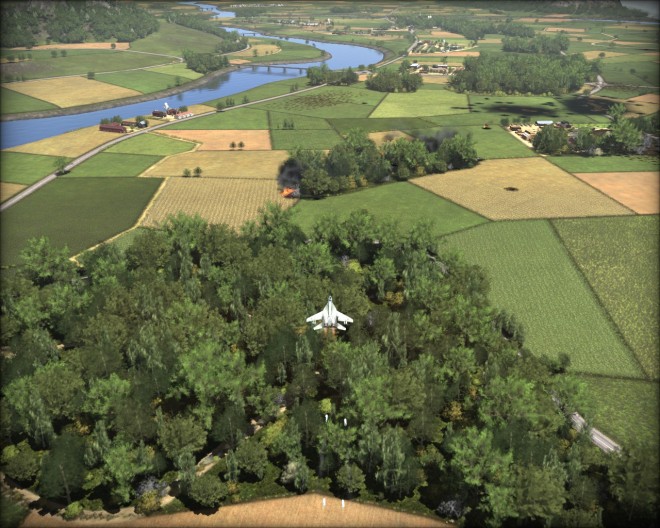
Something else which demands comment, if not at length, is the unit chatter. There is very little of it, which is a shame, the whole Wargame series could have benefited from some Homeworld style, professional and soldierly sounding, ambient chatter. Instead, units report when they are under fire—accompanied often by an alarming sounding klaxon which grates already shredded nerves— report when they are selected, or when ordered to do something. What is worthy of comment about these reports is that while they differ between unit types, they don’t differ across languages. The helicopter pilots of both the NATO and Warsaw PACT nations will all occasionally whistle Ride of the Valkyries when you order them to do something. Similarly artillery units of all nationalities will occasionally opine to you about the civilizing effects of artillery on warfare. This pattern is repeated across all unit types, and while a cynical part of me supposes that it is probably the result of a smallish budget for script, another part of me hopes that it is an attempt to represent the universality of soldiering. These men, separated by language and ideology are, for all that, so similar in temperament that their lines are essentially interchangeable when translated. There is a surprisingly humanistic and universalist message to find, nestled in a game that stresses to much the minutia of differing equipment and doctrines offered by NATO and PACT sides—offering, as it does, over a thousand different units. These differences, the game might be suggesting, are only skin deep. So, perhaps, the game offers not only a slice of Cold War authenticity, but also a slight commentary on the absurdity of the war that never happened.
There are of course, problems. Airland Battle’s delicious Cold War paranoia only really arises in the multi-player game, the AI in the single player is quite simply too stupid to be able to inspire such hatred. The campaign mode is welcome, and packed with interesting ideas, however in single player these again mostly go by the wayside because the AI cannot handle them. Further, if one only encounters the single player game, one also misses the great depth and play possibilities of the system. Instead of spreading one’s forces out, it is better to clump them against the inevitable horde of tanks and infantry that the AI throws recklessly down main roads towards one’s lines. Instead of having a loosely thrown net of recon assets, it is better to have a few recon helicopters positioned almost on top of one’s own forces, as the AI is not only an idiot, but they also cheat like buggery—it is not uncommon to see whole companies of the AI’s forces trundling in a conga line towards an area where you have hidden some stealthy recon infantry. Further, with over a thousand units in the roster, balance has never been perfect, and it really could never be (this is a problem which is exacerbated by Airland Battle’s successor, Red Dragon, which further expands the roster and timeframe). I will not here offer my thoughts on what is balanced and what is not, it will suffice here to say that there have been many different “metas” in Airland Battle’s history, all of which have caused a blossoming of internet “discussion” on Eugen’s forums.
I urge you however, to look past these problems and experience the game for yourself. They are most certainly not deal breakers if you have ever been interested in unique multi-player experiences –and Airland Battle is certainly that. It is a marvellous, brilliantly clever and evocative, game which revels in its theme. Go, play it, think about it, love it. Please.
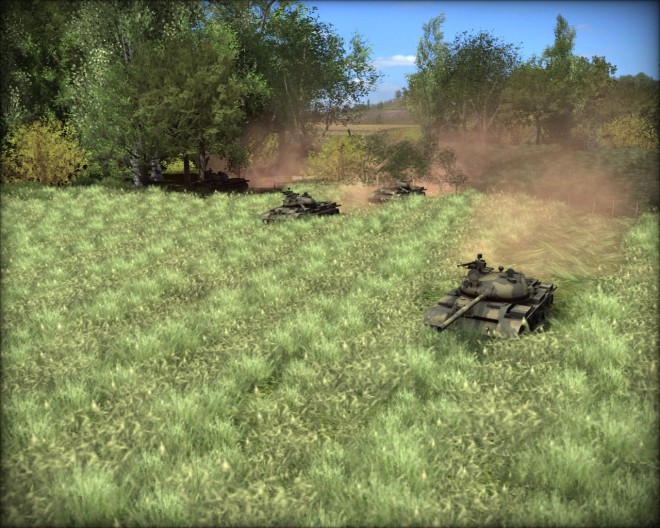
[…] everyone. Wargame Airland Battle is, as I have already said at some length one of the best games of the last decade. Because of this (and because we mussed up recording some […]
LikeLike